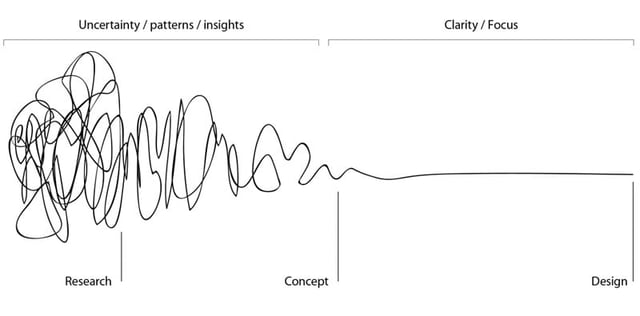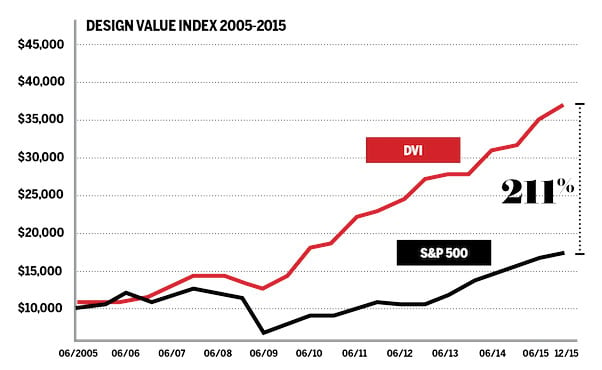“Design Thinking” is being talked about and put into practice by businesses more now than ever. Why? The promise of Design Thinking is to enable companies to tackle complex business problems by putting customers first, understanding needs, envisioning new experiences and converting those insights into value for the organization. Despite its name, Design Thinking isn’t just for “Designers”, but experts in other disciplines may have trouble understanding what it is and their role in the process. In this post, I'll tease out the differences between Design and Design Thinking, try to clarify some of the language we use and demonstrate the value Design Thinking can provide.
It Starts with Design
I find it useful to describe Design Thinking as an extension of the core principles of design. Of course, the word “design” has so many uses. We talk about artifacts or concepts that are produced as “designs.” We describe the process of thinking through and addressing a problem by saying “We designed it together.”
The School of the Art Institute of Chicago offers the following definition for design:
Design is about [...] conceptualization and creation of new things: ideas, interactions, information, objects, typefaces, books, posters, products, places, signs, systems, services, furniture, websites and more. Designers imagine and make. They also research and think. Skilled in one or more specialties of the discipline, designers use their abilities in collaboration with others. Designers want to make ideas real and to make a difference.
This robust definition includes artifacts, collaboration, creativity, problem solving and outcomes. The term “Design Thinking” specifically focuses on the methodology that is separate from design making.
A Snapshot of Design Methodology
“The Design Squiggle” by Damien Newman is an expressive summary of the design process. Take a look:

This drawing is so simple, but captures so much. Here’s what it says to me:
- Finding your way early on is challenging.
- It’s a struggle filled with uncertainty that requires patience.
- The path to success isn’t immediately clear.
- It is structured but not linear.
- While the path becomes smoother toward the end, it still takes time and care to craft solutions to the problem.
I’ve seen designers and non-designers alike use this diagram (or one like it) to give a snapshot of a design project to collaborators and clients. But even here, design is shown as the last segment of the process. Why is that flawed? Keep reading.
A Core Set of Principles
When you see the word “design” next to someone’s degree or job title, it’s likely accompanied by a modifier like “user experience” or “interior” or “industrial.” These design disciplines have evolved and diverged over time to address the unique considerations in their problem spaces, the use of different materials, the standards that govern them and the tools and skills required to craft solutions. But, at their core, is a common set of principles.
To solve problems, Designers listen, learn, conceptualize, make and iterate. Then, the solutions created are “released” into the world, and the cycle of learning continues. Through all this, designers in all disciplines work with the following guiding principles in mind:

- Empathy—A focus on end customers and consideration of not only the usefulness and usability, but also the emotional experience.
- Learning by Making—Making is part of a Designer's thinking process; it helps them feel the impact of their decisions and convert the conceptual into the tangible.
- Co-creation—Solving problems in teams, often with customers, enables the generation of a richer set of ideas to consider, combine and select.
- Synthesizing analytical and creative thinking—The sources of information are not monolithic. Designers process this information and make choices based on an integration of intuition, reason and imagination. This was coined “integrative thinking” by Graham Douglas in the 1980s and popularized more recently by thought leader Roger Martin.
- Iteration and learning—Prototype and engage end customers to learn and evolve ideas and concepts.
These principles are the foundation, and design methods enable us to remain true to them in the work Designers do. This is true whether you’re a team of one, ten, or a thousand.
So, How Is Design Thinking Different?
In Tim Brown’s 2009 TED Talk, he suggests that the role of design has largely evolved into a “tool of consumerism” focused on artifacts, but asks us to “Think Big” by focusing on finding more impactful problems to solve.
To reiterate, the promise of Design Thinking is to enable companies to tackle complex business problems by putting customers first, understanding their needs, envisioning new experiences and converting those insights into value for the organization. As with specific design disciplines, the core principles of design apply to Design Thinking. But, the two bookend principles below highlight two key differences between design and Design Thinking:

- Not just for designers—Design Thinking is a cultural shift that engages people with knowledge, skills and creativity to define and solve problems in teams. You don’t need the word “designer” in your job title. In his 2009 book “Change by Design,” Tim Brown wrote, “Design is now too important to leave to designers.”
- Recognized as critical to business success—When the leadership of an organization sees Design Thinking as a differentiator, there is a commitment to learn, try new ideas and focus on customers continually.
We draw upon these principles as we address bigger and more meaningful problems that require diverse skills and teamwork. The methodology, principles and artifacts used that enable us to learn and model are common to the design disciplines. But Design Thinking goes beyond a design department, silo, or step at the end of the process. Design Thinking enables organizations to tackle large, complex problems and find new ways to improve their relationships with end customers.
Why Use Design Thinking?
Design Thinking is often linked with innovation and business growth. It’s how companies can identify high-value unmet needs and use those insights to create new value. The idea of “value” is key here. Who ultimately decides the value of a new product or service? Customers. An idea can be new and innovative, but the end customer may not understand or experience the value created and therefore not adopt it. Design Thinking focuses on end customers and their world to find unmet needs that customers value the most. Based on your competitive space, some of these may become opportunities to innovate while others are cost of entry or “me too” improvements.
The age old question is “Why should we believe in this? What’s the ROI?” In 2015, The Design Management Institute (DMI) created a Design Index to measure the performance of “design-centric” companies compared to the S&P 500. What makes a company design-centric? Companies in the index met the following criteria:
- Design operates at scale across the enterprise.
- Design holds a prominent place on the company org chart, and either sits on the leadership team or directly reports to a leadership team member.
- Experienced executives manage the Design function.
- Design sees a growing level of investment to support its growing influence.
- Design enjoys senior leadership support from the top tier of the organization.
- The company has been publicly-traded on a U.S. exchange for the last ten years and thereby adheres to GAAP accounting rules.
The results? Design-centric companies show a 211% return over other S&P 500 companies.

Getting Started With Design Thinking
Whoa! The Design Value Index contains some big companies. Does this mean that Design Thinking is only for the big firms? Absolutely not. Here are some steps you and your team can take to become more design-centric:
- Understand Your Problem Space
Use “systems thinking” to explore outside of your specific product or offering and understand how your product or service fits into people’s lives. Define the market opportunity, and look at trends to define growth potential. Find trends in technology, policy and behaviors that may affect customer expectations and how you might connect with your customers.
- Get to Know Your Customers
Talking to customers and walking a mile in their shoes helps us develop real empathy by more deeply and personally understanding goals, pains and journeys. It can be a small investment that energizes a team and helps us connect as people with the problems we’re trying to solve. This can also circumvent the churn of internal debate that occurs when customers are not well understood.
- Create Feedback Loops
Use surveys, interviews, customer service statistics, sales data and any other information you can think of to learn how well your product or service is being received in the world. Use that as input to ongoing planning and strategy.
- Start Small
Rolling out a new approach across the company from the start is risky, and failure can set you and your efforts back. Find a project, an area of your business or research work that can be used by multiple projects to find a win, and build from there. Engage users early to understand, co-create, get feedback, learn and adjust course quickly.
- Establish Metrics and KPIs to Measure and Track Impact
In order to know if your efforts make an impact, you’ll need to measure aspects of your business tied to your changes. These can focus on customer interactions, project team performance, customer service feedback and ultimately, financial measures. Don’t forget to stay in touch internally to understand how the company perceives the change, and get their input about how it could be improved. - Establish Leadership and Get Training, Outside Help
You may be fortunate enough to have an internal Design Thinking leader who can champion change in your organization. You can also hire that leader and empower them to make that change happen within your organization. And they don’t have to go at it alone. There are outside companies that can help a leader scale that change through coaching and training to transform the way an organization thinks and works.
Design Thinking and Consulting Projects
At Summa, we often help organizations tackle problems that cut across operational areas. As an example, we at Summa have been working with a global coatings manufacturer to replace a suite of aging software tools used by distributors and end customers to formulate and mix colors to repair cars, trucks and industrial equipment. When you start digging into how relationships with their customers work, the list of the people, teams, technologies and services involved is large. Here is a list of the groups involved:- Global Leadership Team
- Regional IT and Business Leaders (a group of ~10 representing regions)
- Regional Sales and Support Teams
- Distributors (individual locations and networks)
- Repair Shop Owners (individual locations and networks)
- Regional Customer Service Teams
- Current Product Development and Support Team
We used the principles of Design Thinking as we researched, learned, empathized, co-created and envisioned a better future state for the relationship with their customers. We worked with a globally distributed team to prioritize opportunities and create a roadmap that synthesized the needs of customers, the goals of their business and the possibilities and constraints of technology. And through all of this, our client team still had their regular day jobs to contend with. None of this would have been possible without the executive-level sponsorship, follow-up communication and collaborative checkpoints inherent in this Design Thinking approach.Our client sees both the need for and the benefits of Design Thinking. But to them, the focus wasn’t on changing how their people and teams solve problems together beyond this project. This is but one of many initiatives in their portfolio, but it is one successful example of how teams can work in new ways. Perhaps one example of an approach that can be learned from, improved and used on more of their initiatives over time.
Other Interesting and Relevant Reads
- 2009 TED Talk urging us to “Think Big” — Tim Brown says the design profession has a bigger role to play than just creating nifty, fashionable little objects
- The Art of Integrative Thinking — Roger Martin outlines why modern leadership needs to embrace complexity, tolerate uncertainty, and manage tension in searching for creative solutions to problems
- Building a Design-Driven Culture — Digital McKinsey’s take on Infusing your organization with a design-driven culture that puts the customer first may provide not only real, measurable results but also a distinct competitive advantage
- The 2015 Design Value Index — performance of a portfolio of 16 publicly traded stocks from companies considered to be “design-centric” as compared to the S&P 500
- Diagramming Design Thinking Methodology — while core principles exist, Pinterest provides a view of the many expressions of Design Thinking put into practice
- How to Measure the ROI of Design Thinking —
- The Value of Design — The Design Management Institute provides tools and insights about measuring organizational “design maturity” and the benefits of design
- DMI’s 2015 Design Value Index — A portfolio of 16 publicly traded stocks from companies considered to be “design-centric” contingent on a set of criteria that reflects best practices in design management
-
Shh! Don’t Tell Them There’s No Magic In Design Thinking — Jared Spool shares his perspective on how Design Thinking is a reframing of design


